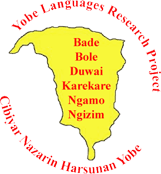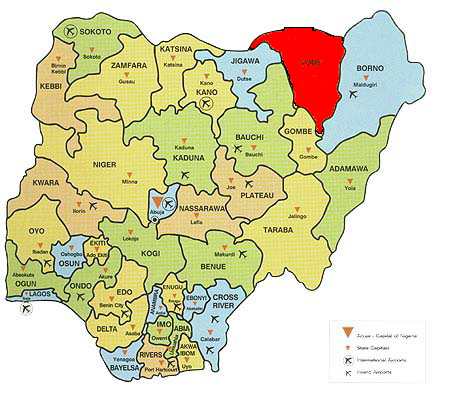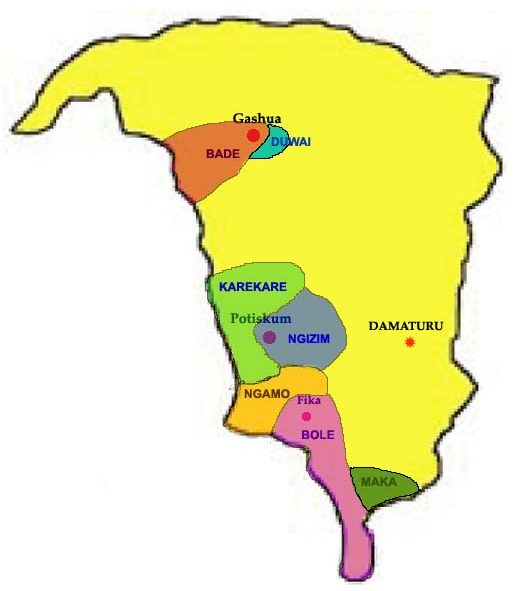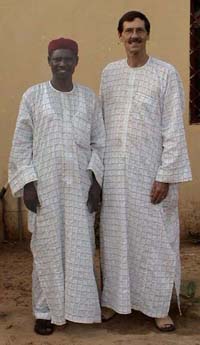The Yobe Languages Research Project

Yobe State, Nigeria is located in northeastern Nigeria. It was, at one time, part of Borno Province. The dominant linguistic and cultural force until the mid 20th century was Kanuri, but in recent decades, Hausa has become the universal lingua franca for all of northern Nigeria, including Yobe State. Nonetheless, numerous minority languages remain in active use.
Yobe State map:

There are seven such languages indigenous to Yobe State: Bade, Bole, Duwai, Karekare, Maka, Ngamo, and Ngizim:

With the exception of Bole, which has many speakers in Gombe State to the south, these languages are almost entirely concentrated in Yobe State. All these languages are members of the West Branch of the Chadic language family, the family to which Hausa also belongs, though they are only distant cousins of Hausa within West Chadic:

Aside from a few scholarly articles, primarily written by Johannes Lukas and Russell G. Schuh, there is very little published documentation of any of these languages, yet they all have substantial communities of first language speakers. Lack of documentation, plus interest in the communities in seeing their languages developed through publications in and on them, makes Yobe State an ideal place for a broad linguistic project, which, on the one hand, assembles data from the languages, and on the other hand, has output of interest and value to the speakers of those languages. The Yobe Languages Research Projecthas these dual goals.
This project has been funded by two grants from the US National Science Foundation: “The Chadic Languages of Yobe State, Nigeria” from 2001-2004 (award #BCS-0111289, Russell G. Schuh Principal Investigator) and “Lexicon, Linguistic Structure, and Verbal Arts in Chadic Languages of Northeastern Nigeria (DBP, KAI, NGH)” from 2006-2009 (award #BCS-0553222, Russell G. Schuh, Principal Investigator).

From 2001 through 2004, Russell G. Schuh (Principal Investigator) of UCLA and Alhaji Maina Gimba (In-Country Director) of the University of Maiduguri directed teams of 2-4 speakers of five of the languages listed above (Bade, Bole, Karekare, Ngamo, Ngizim). In each of its three years, the project produced locally printed and distributed publications in each of the languages, including collections of texts and “verbal arts” in each language and preliminary Language-English-Hausa dictionaries in each language. A number of technical linguistics papers have also come out of the project.

The first three-year project revealed that much remained to be learned about the ingenous languages of Yobe State. Besides additional facts remaining to be learned about the individual languages, it became clear that Yobe State is a linguistic area (actually two linguistic areas–the southern area around Potiskum and the northern area around Gashua), with interlanguage and intercultural influences running across the various socio-linguistic communities at all levels–vocabulary, syntax, verbal arts (idioms, metaphorical expressions, proverbs), and songs. Moreover, there are two additional Yobe State languages indigenous to Yobe State that were not part of the first project–Duwai and Maka. The second three-year project, beginning in 2006, has taken a more cross-linguistic approach than the first. Conventionalized linguistic expressions larger than the word, such as idioms and metaphorical expressions, have been being actively collected, as have terms for shared cultural times (foods, articles of clothing, types of mats, etc.). Such verbal arts are particularly relevant as part of an endangered languages project inasmuch as such areal and culture-specific linguistic items are rapidly giving way to Hausa language and culture. In addition to this expansion of scope over the first project, the project now includes Duwai as a sixth target language. Of the six languages, Duwai is the most threatened. Because of limited time and resources, the project has not been able to incorporate the seventh Yobe State Chadic language, Maka, for full-scale documentation, but a small amount of information on Maka was collected in 2007, and hopefully, more work on Maka will be possible.
The purpose of this web site is to make information about the seven Yobe languages widely available. Click on the links below and in the list to the left to see, hear, and read more!

